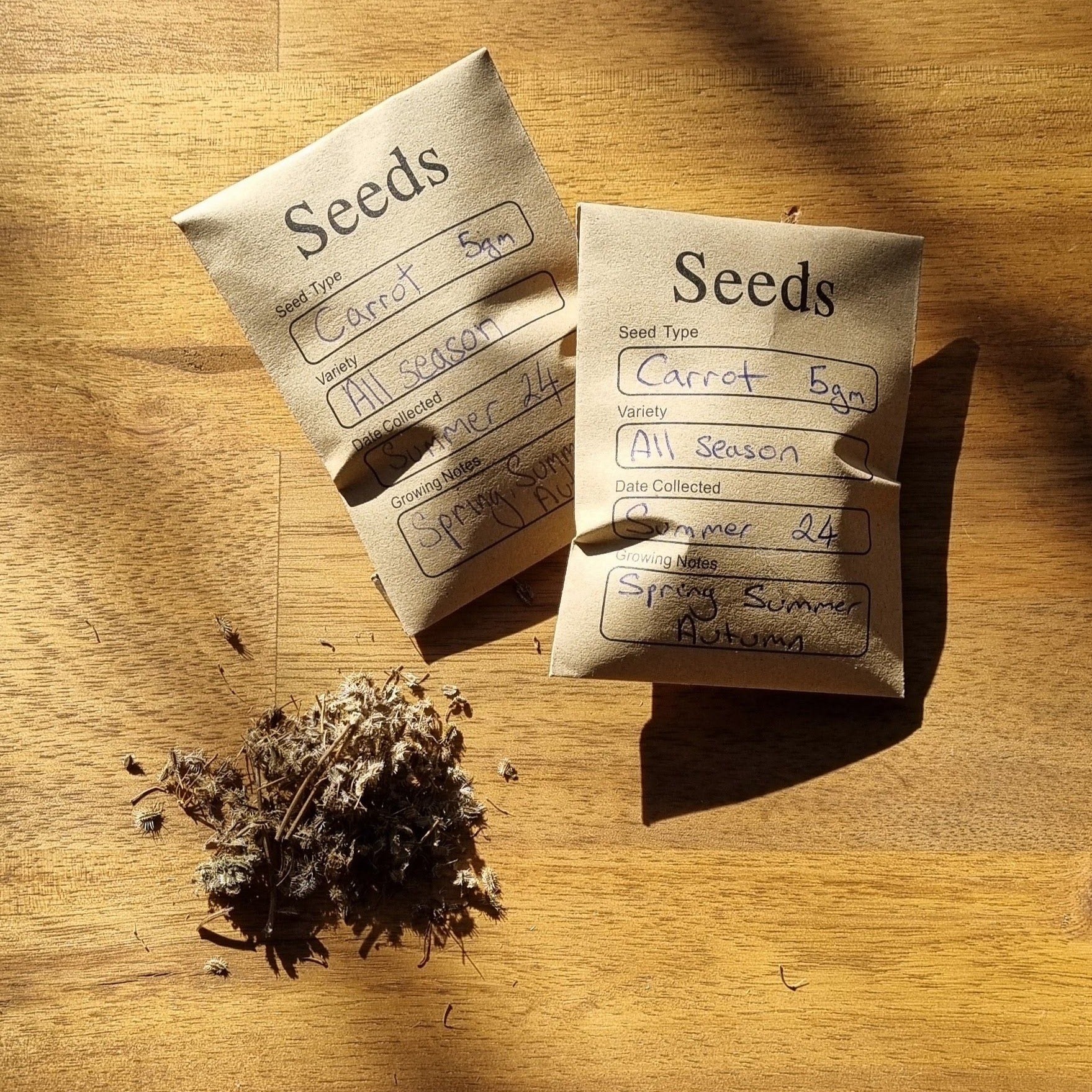Our Youtube channel for more
How to Save Seeds and Grow Carrots on a Permaculture Farm
The Importance of Seed Saving
-Adaptation to Environment
- Seeds saved from your plants are adapted to your local climate and soil.
- Each generation becomes more resilient to local pests, diseases, and weather patterns.
- Soil Compatibility
- Seeds saved from plants grown in your soil are better suited to its nutrient profile.
- This leads to healthier plants and higher yields over time.
- Sustainability
- Reduces dependence on commercially produced seeds.
- Encourages biodiversity and self-sufficiency in your garden.
Planting Carrots on a Permaculture Farm
1. Prepare the Soil
- Use compost made from FOGO (Food Organics and Garden Organics) waste to enrich the soil.
- Ensure the soil has a pH between 6.0 and 6.8. Test and amend with lime or sulfur as necessary.
2. Scatter the Seeds
- Broadcast the carrot seeds evenly across the prepared bed instead of planting in rows.
3. Thin the Seedlings
- As the seedlings grow to a few inches tall, thin them out by harvesting the baby carrots.
- Enjoy these tender young carrots in salads and snacks.
4. Allow Space for Growth
- Thinning the seedlings gives the remaining carrots more room to grow bigger and stronger.
5. Harvest After Frost
- Wait for the first light frost of the season before the main harvest.
- Frost converts starches to sugars in carrots, making them sweeter and more flavorful.
By following these steps, you can save seeds that are increasingly well-suited to your environment and enjoy a bountiful harvest of delicious, sweet carrots from your permaculture farm.
MORE INDEPTH
The Importance of Seed Saving: Cultivating Resilience and Flavor on Your Permaculture Farm
Seed saving is an age-old practice that has been the backbone of sustainable agriculture for centuries. As modern farming increasingly relies on commercially produced seeds, the practice of saving seeds is seeing a revival among permaculture enthusiasts and small-scale farmers. This resurgence is driven by a recognition of the numerous benefits that come with cultivating and preserving your own seeds, especially those that have acclimatized to your unique environment and soil type.
Climatised Seeds: A Natural Fit for Your Environment
One of the primary advantages of saving seeds is that they become better suited to your local environment over time. Seeds harvested from plants that have successfully grown in your garden are naturally selected for their ability to thrive in your specific climate and soil conditions. Each season, as you save and replant seeds from the healthiest and most productive plants, you are effectively breeding a crop that is increasingly resilient to local pests, diseases, and weather patterns. This localized adaptation not only enhances the health and productivity of your plants but also reduces the need for chemical interventions.
Enhancing Soil Health and Crop Performance
In permaculture, maintaining soil health is paramount. Saving seeds from plants that have grown in your soil type ensures that future generations of these plants are well-suited to the existing nutrient profile and structure of your soil. Over time, these seeds develop a symbiotic relationship with the microorganisms in your soil, leading to improved plant health and higher yields. By creating a closed-loop system where seeds are saved and replanted, permaculture practitioners can foster a self-sustaining and regenerative agricultural ecosystem.
The Carrot Chronicles: From Seed to Table
On my permaculture farm, one of the crops I particularly enjoy growing is carrots. The process begins with preparing the soil, which I enrich with compost made from FOGO (Food Organics and Garden Organics) waste. This compost is rich in organic matter and essential nutrients, creating an ideal environment for carrot growth.
Carrots prefer a slightly acidic to neutral pH, ideally between 6.0 and 6.8. To ensure the soil is in the right range, I test it periodically and amend it as necessary with lime or sulfur. Once the soil is ready, I scatter the carrot seeds across the prepared bed. This broadcasting method, rather than planting in rows, mimics natural seed dispersal and can lead to a more resilient crop.
As the carrots begin to grow, I practice a method of thinning known as selective harvesting. When the seedlings reach a few inches in height, I start to weed out the baby carrots. These young carrots are tender and delicious, perfect for salads and snacks. This process not only provides a continuous harvest of fresh produce but also gives the remaining carrots more space to grow larger and stronger.
Frost: The Sweetening Touch
One of the most delightful aspects of growing carrots is their response to frost. After a light frost, the starches in the carrots convert to sugars, resulting in a sweeter and more flavorful root. I always look forward to the first frost of the season, knowing that my carrots will taste even better. This natural process enhances the nutritional value and taste of the carrots, making them a highly anticipated treat on the farm.
Conclusion
Seed saving is more than just an agricultural practice; it is a commitment to biodiversity, sustainability, and food security. By saving seeds, you can cultivate plants that are uniquely suited to your environment, improve soil health, and enjoy a more resilient and productive garden. On a permaculture farm, where the principles of natural ecosystems guide every decision, seed saving becomes an integral part of creating a harmonious and self-sustaining agricultural system. Whether you are growing carrots, tomatoes, or any other crop, the benefits of seed saving will enrich your garden and your table for generations to come.







